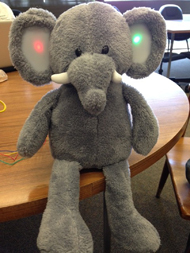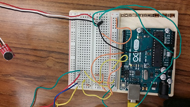ABSTRACT:

INTRODUCTION/BACKGROUND:
The development of hearing and speech for children is crucial for them to be able to communicate verbally to others. The implementation of early intervention techniques for children with hearing loss shows a significant improvement than similar children that receive intervention later. Therapy techniques are designed to improve speech and language skills, but are limited in the techniques to do so. The methods currently used for the children with these difficulties are cochlear implants, hearing aids, and aural re/habilitation. Without the involvement of early intervention techniques the child may have more difficulty performing in school or any social activity than if therapy was not used. Many times, children who have significant hearing loss or even deafness do not make verbal communication due to their lack of knowing if sound is being produced when they speak. Because of this, they minimize the amount that they talk which can have detrimental effects, as they get older. Early intervention is the best method for the development of sensory skills. Currently, therapists use sets of words that are tailored for each child to practice saying and monitor their progress from session to session. These techniques have limitations such as keeping the child’s attention, accuracy for collecting data, and effectiveness. The experience of the therapist plays a large role in how effective these techniques work. There are currently limited devices used for therapy treatments targeted for children with significant hearing loss or speech/language delays and no devices that use visual stimulation for such therapies.
PROBLEM STATEMENT:
There is a need for a device that can be implemented as therapeutic means for children with speech/auditory disabilities.
DESIGN AND DEVELOPMENT (METHODS AND APPROACH):
Aesthetics: The device must be appealing to the target age that this project is designed for. Aesthetics is one of our most important components for this product because it is what will draw the children into using the toy. Without an aesthetically appeasing product the children will not engage with the characteristics of the device and not be able to improve the children’s disabilities. The hand held toy with LED lights consists of an elephant that is not gender specific so that it can be held and played with by both girls and boys. This way the child will be able to interact with a physical toy instead of a computer application or just having the toy move by itself.

Range separation: The data collection is separated into two ranges of Hertz. The ranges below 1000 Hertz recognize the vowel throughout the speech. The range greater than 1000 Hertz recognizes the consonants throughout the children’s speaking. The input is the children’s voices and the output is the Hertz value. This works by using a fourier transform algorithm embedded in the code that filters the high and low frequencies given by the sound sensor.
Notification System: The design has two different LED lights as the notification system. Each LED is connected to the Arduino digital output pins and has a 330ohm resistor between the power source and the LED. One LED is red and the other green. The color of the light turns on depends on the frequency. If it is less than 1000 Hz it will turn red and if greater than 1000 Hz it will turn green. The input is the Hertz value and the output is the LED lightings corresponding to the Hertz ranges.
The device will have a sound sensor that will detect the speech and sounds of a speaking child and separate it into two different ranges of Hertz. One range will be below 1000 Hz to detect vowel letters, and the other range above 1000 Hz to detect consonant letters. For each range of Hertz there will be a corresponding light that will light up when the child speaks. This device will give the child a notification system showing that their voice does work, which will motivate them to keep developing their vocal chords. With successful therapy lessons and early intervention with this device, the child will develop their speech and language comprehension much faster than before.
| Arduino Uno rev3 | $25 |
|---|---|
| Sound Sensor | $7 |
| 9V Battery Snap Adapter | $3 |
| Protoboard | $4 |
| Doll Material (Cotton/Polyester) | $10 |
| Spatula and Velcro | $10 |
| Glue | $4 |
EVALUATION AND RESULTS:
Originally, the product will be implemented in pediatric facilities like Heartspring where research would be conducted to validate our products effectiveness. With reliable data and testimonies, the product will prove that this method for treatment is effective. This will motivate people to purchase the product for use in their homes or clinic.
A device currently used at Heartspring was evaluated for results. The device used is a doll that has a baby monitor inserted in it. This showed positive results with assisting children with speech/auditory deficiencies. The current device had only one LED and no specific data to record. It also has too many wires that is not user friendly for the physicians or users. The LED notification system shows good results in that it motivates children with hearing disabilities to continue speaking so their vocal chords continue to develop and they are not underdeveloped or behind.
DISCUSSION AND CONCLUSIONS:
The developed prototype will allow children to be able to hold the elephant and speak to it, while playing. This device will give the child a notification system showing that their voice does work, which in return will motivate them to keep developing their vocal chords. Without having something like this toy, children do not have a way of recognizing that there voice has an effect and they stop trying to make sounds or speak. Our device is not like anything that is out on the market for children with disabilities.
With successful therapy lessons and early intervention with this device, the child will develop their speech and language comprehension much faster than before. The usefulness of this device will extend from just being used in therapy sessions at facilities to being used as an everyday toy at home.
REFERENCE:
Facts Related to the Prevalence, Academic and Economic Impact, and Technology for Management of Childhood Hearing Loss. (n.d.). Retrieved April 17, 2015, from http://choices-delaware.org/wp-content/uploads/2010/07/Documented-Facts-on-Hearing-Loss-in-Children.pdf
ACKNOWLEDGMENTS:
A special thanks to everyone at Heartspring, Dr. Brooking, and Tom McGuire for their guidance throughout the process.
Audio Version PDF Version